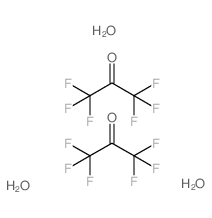13098-39-0
| 中文名 | 六氟丙酮倍半水 |
|---|---|
| 英文名 | 1,1,1,3,3,3-hexafluoropropan-2-one,trihydrate |
| 英文别名 |
Hexafluoro-2-propanone sesquihydrate
MFCD00149063 2-Propanone,hexafluoro-,sesquihydrate 1,1,1,3,3,3-Hexafluoroacetone sesquihydrate Hexafluoroacetone 1.5-hydrate Acetone,hexafluoro-,sesquihydrate Hexafluoroacetone sesquihydrate |
| 密度 | 1.496g/cm3 |
|---|---|
| 沸点 | 234.3ºC at 760mmHg |
| 熔点 | 10ºC |
| 分子式 | C6H6F12O5 |
| 分子量 | 386.09000 |
| 闪点 | 104.3ºC |
| 精确质量 | 386.00200 |
| PSA | 61.83000 |
| LogP | 3.16730 |
| 外观性状 | 无色液体 |
| 蒸汽压 | 5010mmHg at 25°C |
| 储存条件 | 库房通风低温干燥,与氧化剂,及食品分开储运 |
| 稳定性 | 化学性质:对热稳定,300℃长时间加热不发生分解。于550~625℃才开始热解。六氟丙酮的反应性强,与水及许多亲核试剂发生激烈反应生成加合物。例如与等摩尔的水发生放热反应,生成1水合物。这是具有偕二醇结构的一种醇,在熔点以上存在下列平衡。 有过量水存在时形成稳定的水合物。六氟丙酮的水合物如(CF3)2CO·1.5H2O和(CF3)2CO·2H2O常温下为液体,在50~100℃时比(CF3)2CO·H2O稳定。 |
| 分子结构 | 1、摩尔折射率:16.89 2、摩尔体积(cm3/mol):107.9 3、等张比容(90.2K):203.8 4、表面张力(dyne/cm):12.7 5、介电常数:无可用的 6、极化率(10-24cm3):6.69 7、单一同位素质量:165.985334 Da 8、标称质量:166 Da 9、平均质量:166.0219 Da |
| 计算化学 | 1、 氢键供体数量:3 2、 氢键受体数量:17 3、 可旋转化学键数量:0 4、 拓扑分子极性表面积(TPSA):37.1 5、 重原子数量:23 6、 表面电荷:0 7、 复杂度:124 8、 同位素原子数量:0 9、 确定原子立构中心数量: 0 10、 不确定原子立构中心数量:0 11、 确定化学键立构中心数量:0 12、 不确定化学键立构中心数量:0 13、 共价键单元数量:5 |
| 更多 | 1. 性状:六氟丙酮为气体,其水合物常温下为液体。 2. 相对密度(g/mL,23.3℃):1.323 3. 熔点(ºC):-122 4. 沸点(ºC,常压):-27.4 6. 蒸发热(KJ/kg,25ºC):128.5 7. 生成热(KJ/mol):1252 8. 比热容(KJ/(kg·K),0ºC,液):1.61 9. 比热容(KJ/(kg·K),气):1.73 10. 临界温度(ºC):84.1 11. 临界压力(KPa):2.83 12. 蒸气压(kPa,21.1ºC):603.3 13. 蒸气压(kPa,54.4ºC):1468.6 14. 溶解性:可以溶解聚甲醛、聚酰胺、聚酯、聚醇等合成高分子。 |
|
Material Safety Data Sheet
Section1. Identification of the substance Product Name: Hexafluoroacetone sesquihydrate Synonyms: Section2. Hazards identification Harmful by inhalation, in contact with skin, and if swallowed. Section3. Composition/information on ingredients. Ingredient name:Hexafluoroacetone sesquihydrate CAS number:13098-39-0 Section4. First aid measures Skin contact:Immediately wash skin with copious amounts of water for at least 15 minutes while removing contaminated clothing and shoes. If irritation persists, seek medical attention. Eye contact:Immediately wash skin with copious amounts of water for at least 15 minutes. Assure adequate flushing of the eyes by separating the eyelids with fingers. If irritation persists, seek medical attention. Inhalation:Remove to fresh air. In severe cases or if symptoms persist, seek medical attention. Ingestion:Wash out mouth with copious amounts of water for at least 15 minutes. Seek medical attention. Section5. Fire fighting measures In the event of a fire involving this material, alone or in combination with other materials, use dry powder or carbon dioxide extinguishers. Protective clothing and self-contained breathing apparatus should be worn. Section6. Accidental release measures Personal precautions: Wear suitable personal protective equipment which performs satisfactorily and meets local/state/national standards. Respiratory precaution:Wear approved mask/respirator Hand precaution:Wear suitable gloves/gauntlets Skin protection:Wear suitable protective clothing Eye protection:Wear suitable eye protection Methods for cleaning up: Mix with sand or similar inert absorbent material, sweep up and keep in a tightly closed container for disposal. See section 12. Environmental precautions: Do not allow material to enter drains or water courses. Section7. Handling and storage Handling:This product should be handled only by, or under the close supervision of, those properly qualified in the handling and use of potentially hazardous chemicals, who should take into account the fire, health and chemical hazard data given on this sheet. Store in closed vessels. Storage: Section8. Exposure Controls / Personal protection Engineering Controls: Use only in a chemical fume hood. Personal protective equipment: Wear laboratory clothing, chemical-resistant gloves and safety goggles. General hydiene measures: Wash thoroughly after handling. Wash contaminated clothing before reuse. Section9. Physical and chemical properties Appearance:Not specified Boiling point:No data No data Melting point: Flash point:No data Density:No data Molecular formula:2C3F6O.3H2O Molecular weight:386.1 Section10. Stability and reactivity Conditions to avoid: Heat, flames and sparks. Materials to avoid: Oxidizing agents. Possible hazardous combustion products: Carbon monoxide, hydrogen fluoride. Section11. Toxicological information No data. Section12. Ecological information No data. Section13. Disposal consideration Arrange disposal as special waste, by licensed disposal company, in consultation with local waste disposal authority, in accordance with national and regional regulations. Section14. Transportation information Non-harzardous for air and ground transportation. Section15. Regulatory information No chemicals in this material are subject to the reporting requirements of SARA Title III, Section 302, or have known CAS numbers that exceed the threshold reporting levels established by SARA Title III, Section 313. SECTION 16 - ADDITIONAL INFORMATION N/A |
|
毒理学数据: 1、急性毒性:大鼠皮肤LD50:670mg/kg;小鼠口服LD50:300mg/kg;小鼠腹腔LD50:180mg/kg; 2、其他多剂量毒性数据:大鼠皮肤TDLo:2600 mg/kg/2W-I 3、急性中毒动物表现中枢神经抑制状态,后肢步态不稳,复位反射消失,多数在2~6天后死亡。死亡动物肺部充血、出血和水肿。高浓度的六氟丙酮能损害肝脏。其水合物对皮肤有局部刺激作用,对眼结膜或角膜能造成严重损害,给药2个月后角膜完全浑浊,对光反应消失。 CHEMICAL IDENTIFICATION
HEALTH HAZARD DATAACUTE TOXICITY DATA
|
| 危害码 (欧洲) | Xi,T |
|---|---|
| 风险声明 (欧洲) | R24/25 |
| 安全声明 (欧洲) | S36-S45 |
| 危险品运输编码 | UN 2552 |
| RTECS号 | UC2660000 |
| 包装等级 | II |
| 危险类别 | 6.1(a) |
